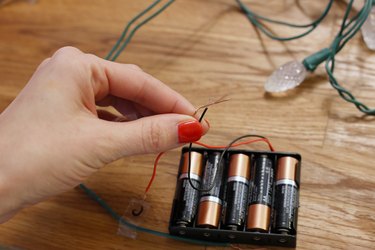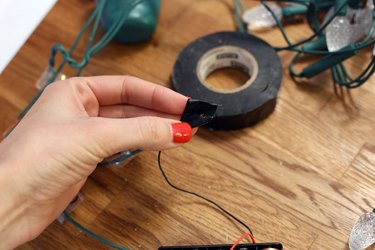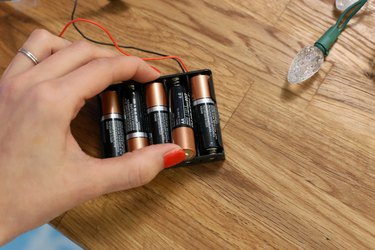
For many people, the holiday season means festive light displays. Whether you want to create a spectacular show or add festive cheer to your home, using a battery pack for Christmas lights is an option for those without an available outlet to plug your lights into. If this is the best option for you, you can power string lights in one of two ways: with a power inverter or by rewiring the lights to run off batteries.
Using a Power Inverter
Video of the Day
Things You'll Need
LED Christmas lights
AC to DC power inverter
12-volt battery
Most holiday lights are wired for standard household alternating current (AC) power and will be unable to run on direct current (DC) without alterations. If you prefer a simpler option and don't feel comfortable with rewiring string lights, then instead of using a battery pack for plug-in lights, opt for a power inverter and a 12-volt battery to power your lights.
Video of the Day
Specifically, you'll need an AC to 12-volt power inverter to complete the job. Power inverters convert DC power from a battery into conventional AC power, which is then used to operate the Christmas lights as well as any number of other devices, from kitchen appliances to computers.
When connected to a 12-volt battery, the inverter draws the power and converts it into a current the holiday lights can process. Experts recommend keeping two battery sources, leaving one to recharge while the other powers the batteries so you can maintain a steady power supply.
Plug your Christmas light strand into the AC/DC inverter. In most cases, the inverter is powered by a 12-volt battery, so be sure you have a new one handy.

Rewiring Lights to Run Off Batteries
Things You'll Need
LED Christmas lights
Batteries as needed
Electrical tape
Battery harness
Step 1: Create a Battery Source
When converting string lights to run off batteries, you will need to cut and rewire the strand so each of the bulbs can receive proper voltage. This method will power the lights for up to two hours. While it might not be best for an outdoor display, this is a useful method for indoor decorations that cannot reach an outlet.
The number of batteries necessary will depend on the type of lights you are using. For example, white, blue and green 3.3v LEDs require 6v, so you will need five 1.2v batteries for lights wired in a series of two and 10 1.2v to power 12v lights wired in a series of four. Red, orange and yellow 2.0v LEDs, on the other hand, will require five 1.2v batteries to power 6v lights wired in a series of three and 10 1.2v batteries for 12v lights in a series of six.
Suppose you are working with standard, non-LED lights with 50 lights per strand, for example. Since a wall outlet supplies 120 volts, each bulb on the strand requires 2.4 volts. You will need eight 1.2v batteries for 9.6v lights wired in a series of four. Begin the rewiring process by cutting the strand into three sets with four bulbs on each set. (Be sure to wash your hands after working with wiring since some outer wiring jackets contain lead.)

Step 2: Connect the Wires
With the power wire connected to the battery, connect it to the wires at the beginning of each set, wrapping the power wire around the other wires to stay organized.
Then, connect the end of each set together, making sure to wrap the return wires in the same manner as the power wire. The return wire should be connected back to the battery pack.

Step 3: Apply Electrical Tape
Use electrical tape on the ends of the wires to make sure that when you are finished wrapping, nothing is exposed.

Step 4: Add Batteries to the Battery Harness
Put the batteries into the battery harness and power up your lights to be sure they work properly.
As with any project involving electricity, you shouldn't undertake this project if you are at all unsure of how to proceed. Instead, buy new Christmas lights or consult a professional electrician for guidance.
